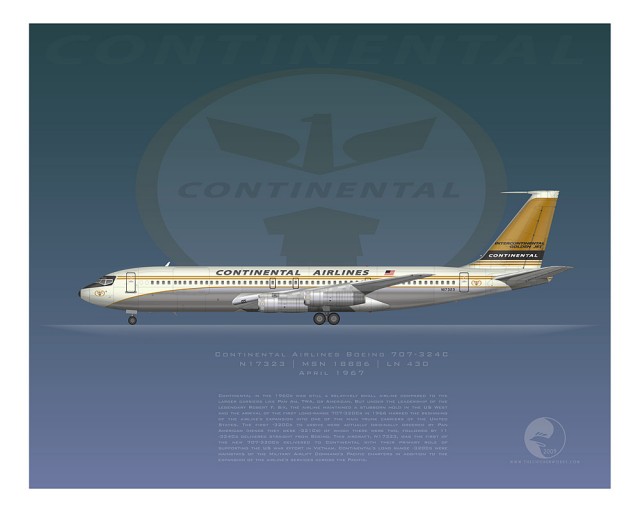
A classic Continental Airlines Boeing 707-300 – Image: JP Santiago
I suppose I was destined to be doing aircraft profile art from a young age. Many of my notebooks and textbooks had aircraft drawings scribbled on the pages and margins, often to pass the time in class. As long as I can remember, I was always drawing airplanes – on the walls of my room, in the margins of a textbook, scraps of paper and a sketchbook here and there, some of which I’m sure are probably tucked away in my parents’ attic to this day.
As a teen, I even took drafting electives to help with my drawings as they began to develop more details and precision. In high school, I had covered the walls of my bedroom with a series of aircraft profiles all to scale — I’m not sure where they are now, but they were done with technical pen and Prismacolor pencils from large aircraft like the Boeing 747 and B-52 Stratofortress, to fighter jets and World War II aircraft. I had a McDonnell Douglas KC-10 refueling a formation of F-4E Phantoms and F-15 Eagles.
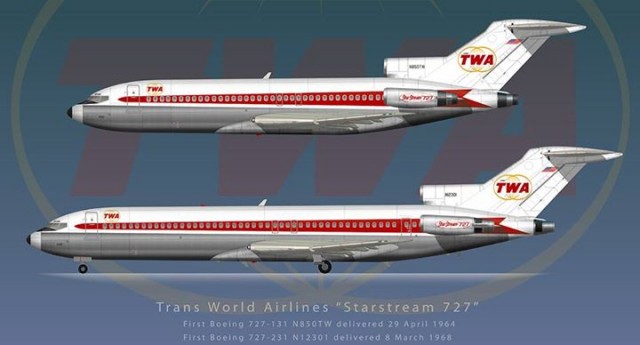
A TWA Boeing 727-100 and 727-200 – Image: JP Santiago
That was probably the start of my interest in “what-if” concepts and unbuilt designs, as there was also a profile of the proposed McDonnell Douglas P-9, a maritime patrol version of the MD-87 powered by unducted fan engines. Through college and medical school I tried my hand at pencil drawings as well, as I was searching for the ideal medium for my artwork. Many of my books were filled with profile art, which I scrutinized, by aviation artist Keith Fretwell.
I was a consummate model aircraft builder (and still am, to some extent, but not to the level of activity that I was before I had kids) which also influenced my own artwork as well. After all, the research I put into a particular model kit had just as much application to my artwork as well. That was probably the first use of the internet for me as an AvGeek.
Around 1993, I discovered the USENET and I’m pretty sure you can find my posts in the rec.models.scale and rec.aviation sections. I still remember my first posting; I was looking for the FS595 colors used for the Mod Eagle camouflage scheme on the F-15 Eagle that was introduced in the early nineties on the Eagles of the Pacific Air Forces before it became standard for the USAF’s F-15 fleet.
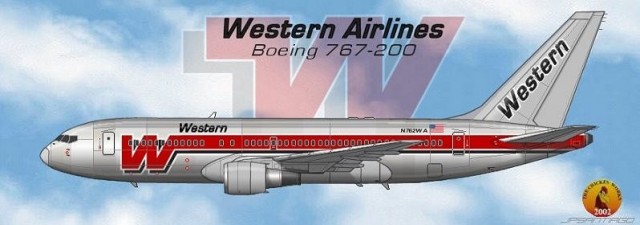
One of my early PSP 7.0 projects, a ’œwhat-if’ subject; a Western Airlines Boeing 767-200 in the ’œBud Lite’ livery. Before their merger with Delta Air Lines in 1987, Western had a small number of 767-200s on order – Image: JP Santiago
When I started out in private practice in the summer of 2000 here in Texas, I began collecting 1/400 scale diecast commercial aircraft. If you haven’t gotten your hands on these little gems over the years, that’s good and bad. Bad in that you’re missing out on some neat little models but good in that collecting those models is worse than a crack habit.
As I learned more about that particular collecting hobby, I ended up signing up and joining a 1/400 diecast aircraft collectors forum. That was in January of 2001, and that was pretty much the first time I realized there were a LOT of people out there who shared my passion for all things aviation.

This was my interpretation of a Pan Am Lockheed L-2000 SST which I had given the name ’œStarliner II’ (which, as far as I know, was never a name used officially by Lockheed for their L-2000 design) – Image: JP Santiago
My screen name then? It was my old multiplayer screen name from when I played Tom Clancy’s Rainbow Six during residency training (yes, we installed Rainbow Six on the university hospital’s network and would battle it out late at night when we were on call as residents) – ’œSentinel Chicken.’ I’ll have to save the meaning of that screen name for a future post, but I still use that screen name on several forums as well as on my Twitter and Instagram.
There were two members on the collector forums who were using computers to create profile art that impressed me. They were graphic designers and artists by profession, who shared my AvGeekiness. Being an early fan of their work, it inspired me to start some very basic and rudimentary computer-based art using the default bitmap editor that was part of the Windows operating system.
I’d share my drawings on the forums, get positive comments, and worked on more. I’d hardly call those pixelated drawings anything special but that was a starting point for me where I had discovered a medium that was comfortable. I wish I knew where the files of those drawings were; one of the earliest ones was my interpretation of the Boeing Sonic Cruiser.
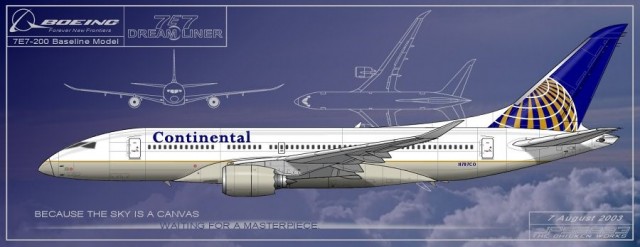
This was one of the last profiles I did before converting to Adobe Illustrator – this dates from 2003 and was when the Dreamliner concept was first unveiled as replacement for the Sonic Cruiser. It was still called the 7E7 then and only a few images had been released, so I had to extrapolate a lot of the details from those early concept drawings – Image: JP Santiago
In early 2002, I decided to get more serious about using software for my artwork, but at that point it was still really a leisure activity for my own amusement and for sharing on aviation-related forums. I didn’t have the cash outlay in those days for Adobe Illustrator, so I started out with Paint Shop Pro 7.0. The earliest art that I do have archived was from those days. Given my online involvement on forums that dealt mostly with commercial aviation, most of my early artwork were commercial airline subjects. That year, with a friend, we started our own aviation collectors forum at Airlinebuzz.com which has been one of my online homes for over 10 years now.

This was a 1961 North American Aviation design exercise for an SST based on the technology as well as components from the XB-70 Valkyrie program – Image: JP Santiago
It sort of became a bit of a joke that I should have had my own company to release some of my conceptual designs and what-if artwork. So in a nod to the Lockheed Skunk Works and my online screen name ’œSentinel Chicken’, the name ’œChicken Works’ was born — that’s how my art studio got its current name.
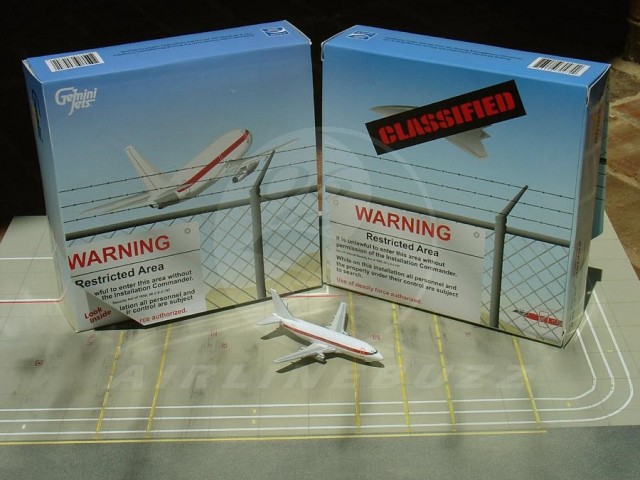
This was the box design I did for the JANET Airways 737-200 that was released in 2006 by Gemini Jets – Photo: JP Santiago
In 2004, I finally made the leap to Adobe Illustrator and that’s still what I use now (I think I’m on my fourth version of Illustrator now with the 2015 version of Illustrator CC). The learning curve with Adobe Illustrator was very steep but it was well worth it, as it opened up new avenues for me in a few short years. One of those avenues was in the box designs for 1/400 scale models from a variety of companies.
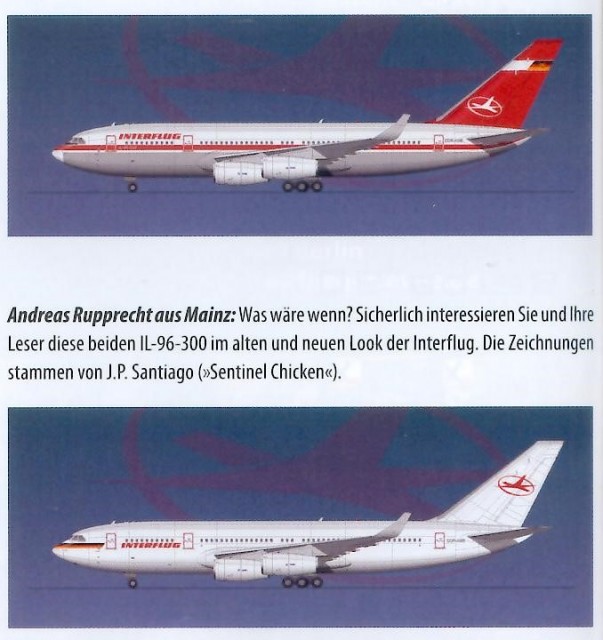
March 2007: The first time my artwork appeared in a publication – Image: JP Santiago
The second avenue that opened up for me was my collaboration with German author Andreas Rupprecht. He had seen some of my commercial aviation ’œwhat if’ artwork of the Ilyushin Il-96 and had shared one in the letters to the editor section of the German aviation magazine Flieger Revue.

There’s 200+ pages that detail the development of Chinese fighter, bomber, and attack aircraft development. The middle profile on the back is my artwork- that’s the Chengdu J-9VI-2, a promising twin-engine canard delta fighter that was in development from the 1970s to 1980s. While it never left the drawing boards, the effort expended on this design and a single-engined version called the J-9VI-1, gave the fighter design groups at Chengdu valuable experience that led to today’s designs like the J-10 – Photo: JP Santiago
Andreas is an expert on Chinese combat aircraft design and development, and he was working on a series of magazine articles for Flieger Revue on many of the unbuilt designs and prototypes that the People’s Republic of China had worked on for many years, which would ultimately influence their current generation of combat aircraft. He asked me to do the artwork for his articles and it was a great experience. His work then moved from Flieger Revue to one of the finest military aviation periodicals ever to be published, International Air Power Review. In the IAPR issues, I’m credited as an artist with my name right next to the name of an aviation profile artist I idolized as a kid — Keith Fretwell!
I have Andreas to thank for what is still one of the best opportunities for me to have as an artist. The work I’ve done for him I’ll have to share later, as it could fill pages and pages, but my work is featured in three issues of IAPR; one issue has my artwork of the development and deployment of the Chengdu J-10 fighter, the second one the development and deployment of the Xian JH-7 fighter-bomber, and a third issue features the Changhe Z-10 helicopter gunship.
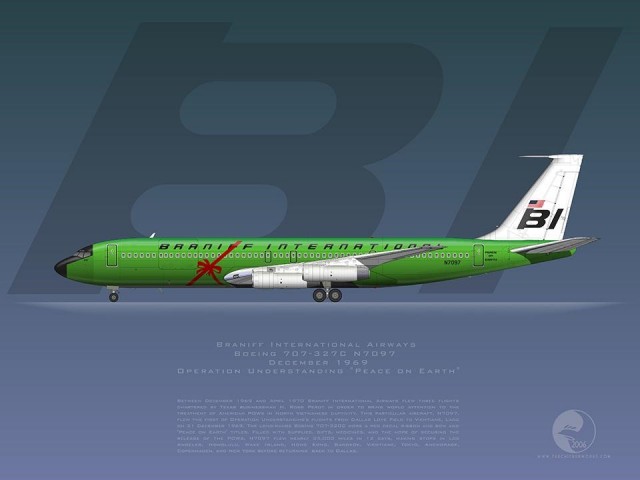
Between December 1969 and April 1970, H. Ross Perot chartered three Braniff International flights to bring international attention to the plight of the American POWs held by North Vietnam. The first of the three flights of ’œOperation Understanding’ used N7907 for a Christmas flight to Southeast Asia via several stops on a 12-day tour to bring gifts for the POWs. The Boeing 707-320C had a ribbon decal applied at Dallas Love Field and ’œPeace on Earth’ titles by the aft passenger door for the flight. The decal unfortunately peeled off on takeoff from Dallas. – Image: JP Santiago
The third avenue (after box art design and published artwork) were my own prints. My wife had always encouraged me to go this route, Lord knows the poor gal has had to deal with aviation as my mistress all these years! The first print I did was in late 2006, and the subject was of a very special aircraft – N7907, a Braniff International Boeing 707-320C with special markings for the Christmas 1969 season.
A friend of mine, who has long been involved with the ex-Braniff employees of the DFW area, had told me about the Perot charters and thought it would make a great debut print for ’œThe Chicken Works.’ He was a valuable resource in making this print possible, sharing what he had found in his own research reviewing archival material. He even arranged for me to meet the last surviving Braniff captain of this flight at his home in North Dallas, where I gave him one of these prints. Captain Phillips passed away in 2012 and I consider myself fortunate to have met him back in 2007. What I didn’t know at the time was that Forrest had also sent a print to Ross Perot himself…who then called me at home out of the blue one evening to thank me for creating the print! I was in the midst of preparing dinner for my kids and had let the call go to voicemail. So when I checked it later, it was Perot himself asking me to call him back, which of course I did right away.
Most of my artwork now falls into one of three categories- commercial aviation, military aviation, and what-if/alternate history concepts. I’d be hard pressed to pick out my favorite one so far – true to my avgeek nature, they all are my favorite! But here’s one from each category:
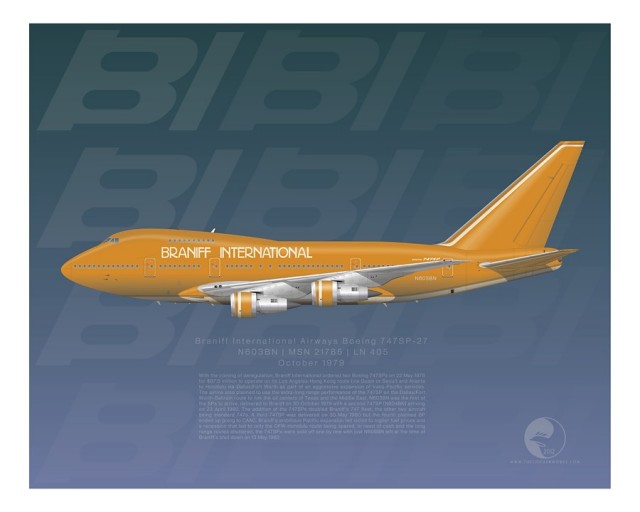
N603BN was Braniff International’s first Boeing 747SP- the airline had ordered them in anticipation of nonstop route authorities between DFW and the Middle East. The services were never approved and North Texas would have to wait until the inauguration of Emirates’ 777-200LR services from Dubai a few years ago before we got the nonstop services to the Mideast that Braniff had long sought – Image: JP Santiago

This is the Convair 58-9 SST- it was based on design studies of more advanced variants of the B-58 Hustler and would have used the same Pratt & Whitney J58 engines used on the SR-71 Blackbird. It would have been an uneconomical design with limited seating capacity, but it sure looks cool in the delivery livery used by Delta’s first Douglas DC-8s – Image: JP Santiago
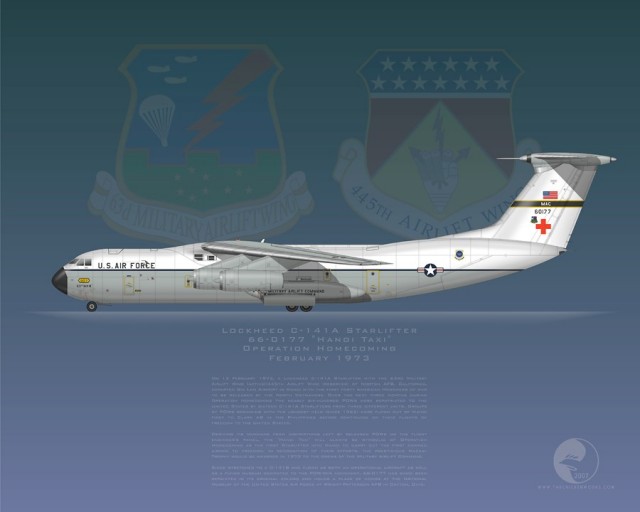
This Lockheed C-141A Starlifter is 66-0177 ’œHanoi Taxi’ as she looked in February 1973 when she flew the first group of freed POWs out of North Vietnam. She was later modified to the stretched C-141B, but before retirement to the USAF Museum was repainted in the old MAC white-top scheme. Despite flying regular missions, she held a special place in the USAF fleet and each crew that operated 66-0177 saw to it that their aircraft’s historical legacy was never forgotten – Image: JP Santiago
These are only a few examples of my work. I have been surprised over the years at how popular my what-if/alternate history concept art prints have been. Usually those are projects I did for myself as a break from real world/historical projects, but they inevitably seem to be very popular when I’ve exhibited my work at local shows. Over the years as I’ve learned new techniques, I sometimes revisit past works and update them to reflect my latest methods.
Like many AvGeeks I’ve long admired your art and knowledge. Fun opportunity to really “get to know you” through your work.
Great piece, JP!
JL Johnson | AirlineReporter
Nice work, have seen your stuff on/at various places! Good talent for aviation art 🙂
Mr. Santiago’s work is some of, if not, the finest in the aviation art forum. His work is expressive and detailed and his passion for excellence shines in every piece. Braniff AIrways Foundation/Braniff Preservation Group fully applauds his magnificent contributions to the history of aviation.
i am a collector of commercial and military aviation art and memorabilia.saturday september 12th there is a great airliner show at the newark airport ramada inn on frontage road,exit 14 on nj turnpike.they have a website =newark airliner show willget you the link.it is always filled with great art and models ,old and new.there are current airline personal as well as retired people who visit and some have tables with memorbilia and art.a retired panam f/a and a retired eastern and capital both have great items.i got some good art there.
Great article JP and a fun review of stuff from the past I’ve seen you create. It has been a good time posting illustrations back and forth over the years and I hope we continue to get these chances many, many more times in the future!
Wow, so beautiful! Thanks for sharing!
Nice to see JP’s excellent work critically acclaimed! I treasure the print of a hypothetical UAL Blended-Wing-Body transport in Tulip livery!
Beautiful work! Is there anywhere I can purchase his art?
Thank you very much for the history on the Braniff International N7907. I know some folks who were “guests” at the Hanoi Hilton at the time. They came home on that C-141, tail number 66-1077. After a long career, it was retired and is now on display at the U.S. Air force Museum in Ohio.